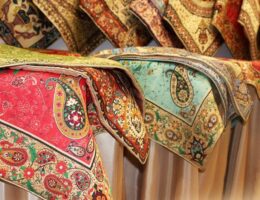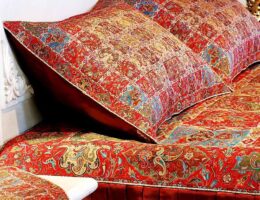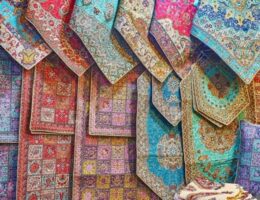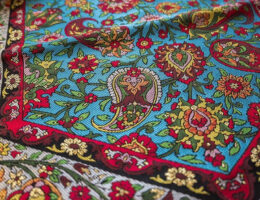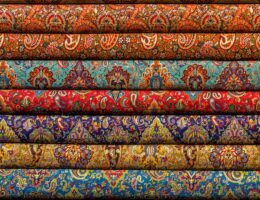IRAN ART EXHIBITION: PERSIAN CARPETS HAS ROOTS IN HISTORY
The originality of Persian carpets or Iranian Rugs dates back to about 2500 years ago. Iranians were among the pioneer weavers of the carpets of ancient civilizations, and over the centuries, creativity and genius achieved a degree of great perfection in this field. Carpet weaving skills are passed down through generations as a highly protected family secret. Tracing the history of Iranian carpets, would help to follow a path for cultural growth of one of the greatest civilizations the world has ever seen.
Even today, with the growing population trapped in the vortex of an expanding industrial society, Persian connections with carpets are just as strong. An Iranian house is bare and soulless without Iranian Rugs that are reflection of the deep ties between the people and their national art.
History of Persian Carpets
Iranians were among the first carpet weavers of the ancient world. The earliest known Persian carpet is called “Pazyryk“. It was discovered in a frozen tomb related to a Scythian ruler in Siberia, and is estimated to dated from about 500 BC. It is now kept in St. Petersburg’s Hermitage museum.
Pazyrik (Pazirik) Carpet
In the 1st Millanium BC, in the Pazyryk Valley located beneath the grasslands of the vast Ukok Plateau, where the borders of China, Kazakhstan, and Mongolia meet, lived the Scythian peoples. Partly nomadic, partly settled, the Scythians are generally believed to have been of Iranian origin. They spoke a language of the Scythian branch of the Iranian languages, and practiced a variant of ancient Iranian religions. These tribes raised huge herds of animals particularly horses. They dug their tombs deep in the frost and covered the deceased with piles of timber and stone. Therefore, all excavated objects from their frozen tombs were unearthed in remarkably preserved condition. The person who discovered the Pazyryk carpet, professor Sergei Rudenko, suggested that is was an artifact from the Achaemenid Empire in Persia. And most carpet scholars also believe that it most likely came from Persia or Armenia. However, its exact origin is still a mystery since both Persia and Armenia have long traditions of carpet weaving, although the horses represented on the rug are nearly identical to equestrians on a frieze in the ancient Persian city of Persepolis.
IRAN ART EXHIBITION: The first documented evidence of the existence of Persian carpets was obtained from Chinese texts related to the Sassanid period (224-641 AD). However, in Greek historiography there is written evidence about the existence, value and quality of Persian carpets.
Carpet weaving art underwent many changes in different periods of Iranian history. It reached its zenith in early Islamic period but declined during the Mongol invasion. After the invasion, the art began to flourish again during the reign of the Timurid and patriarchal Mongol dynasties. In Safavid Era, while architecture and painting were the main artistic fields supported by the government, the textile industry and carpet weaving became also of great importance. In the 16th century, hitherto primarily nomadic crafts were transformed into royal industries by the creation of court workshops. The best known carpets of this era which represent the summit of design, are called Ardabil carpets – dating back to 1539 AD.
Ardabil Carpets
Ardabil carpets are two almost identical exquisite Iranian carpets that were woven during the reign of Shah Tahmasp Safavid – for the tomb of Safavid ancestor, Sheikh Safi of Ardabil. One is now kept in London, in the great museum of Victoria and Albert, and the other one at the Los Angeles Museum of Art.
These rugs are ranked among the most exquisite and famous rugs in the world in terms of design and texture, and are also included in the list of 50 selected masterpieces of art in the world. They were both probably woven by the order of Shah Tahmasp I and as soon as the work was completed in the 13th year of his reign, they were spread on the floor of “Ghandil Khana” hall of the shrine of Sheikh Safi al-Din Ardabili. In 1840, an earthquake occurred in Ardabil, which destroyed the tomb of Sheikh Safi and damaged the carpets. The shrine trustees, in search of a way to finance the reconstruction, found a British company called Ziegler & Partners, which was engaged in the carpet business and was headquartered in Manchester. Ziegler bought the carpets for 80 Tomans and quickly transported them to England and left them in the hands of patient restorers who, in a smooth and safe process, restored both carpets. But a problem occurred during the restoration process: Two carpets came out of the workshop that were no longer paired and matched! One’s fringe was used to restore the other, and the result was the rebirth of a complete rug and another without any fringe.
Characteristics of Iranian Carpets
Iranian carpets are usually made of a mixture of wool and cotton. In Hamadan and Kurdistan regions, camel hair is also used. Silk is also frequently employed to make very finely knotted ones such as Qom and Tabriz carpets. Iranian original carpets are traditionally hand-knotted and consist of strings of warp and thousands of knots constituting the carpet’s weft.
How Hand-Knotted Iranian Rugs are woven?
Iranians were among the oldest carpet weavers of the ancient world and their weaving techniques are at least 2500 years old. The basic construction of a hand-knotted rug has three parts. Cotton yarns are stretched across a vertical loom, forming the “warp” of the rug. Wool yarns are then knotted onto the warp to form the pile of the rug. Finally, the pile is secured in place with cotton yarns woven horizontally through the warp to form the “weft” of the rug.
Persian Knots vs. Turkish Knots
The weaving knot type in a carpet is the main variation you would see in hand-made rugs. There are two main types of knots: the Turkish knot (also called a Ghiordes knot) and the Persian knot (also called a Senneh knot).
Turkish rug knot
Symmetrical knot technique has been applied for at least 2,500 years in Iran. Azeri and Bakhtiari tribes, Kurds and nomads have woven carpets with symmetrical knot and no one still knows why this knot is mistakenly known as the Turkish knot. The symmetrical knot is the strongest knot that is tied to the rug. In a symmetrical knot, the thread passes through the middle of the two strands and comes out of them after going around them. When you pull one end of the thread, the knot becomes tight. Turkish knots are most common in rugs made in northwestern Iran, Kurdistan, Azerbaijan, and of course, Turkey. This strong, symmetrical knot makes for a very consistent pile and is typically used in thicker carpets.
Persian rug knot
Asymmetric knot is known as Persian Knot that is used more often in rugs from central and eastern Iran, Pakistan, and India. In a Persian knot, one half is tied tightly around a warp while the other half is left loose. The resulting asymmetric knot that can be packed together more tightly than Turkish knots, making the Persian knot ideal for high density rugs with extremely detailed patterns.
Types of Persian Carpets
IRAN ART EXHIBITION: There are many types of Iranian hand-woven carpets. Variety in production method, size, material, quality, elegance, subtlety, and variety of design, color, appearance and structural differences have all caused Iranian hand-woven carpets to have special products, each with a specific name.
Urban carpet: means a carpet that is woven in a city workshop. The Iranian urban carpets or city rugs, which are usually woven in city workshops, are normally delicate with relatively high density. Carpet weaving in the cities spread widely during the Safavid period by establishing large carpet weaving workshops in Isfahan and Tabriz.
Rural carpet: It is a carpet that is woven in a simple and basic way in a villages. Iranian Village carpets are often woven without a pre-designed pattern. The size of these carpets is usually small and in the form of a half and a half, back, side and vault. Rural carpets once had characteristics in terms of design and composition, but now, under the influence of market production, they have become uniform and are in danger of extinction.
Nomadic carpets: Nomadic and tribal carpets, like rustic carpets, are simple and primitive with patterns inspired from the environment and tribal life. Nomadic rugs are available in small sizes and are relatively rough. The fringe of a tribal rug has a complex texture that is often attached to short woolen tassels at regular intervals. Gabbeh, Jal, Sofreh, Namkdan, and Poshti are some of the nomadic carpet products.
Iran’s main Carpet weaving centers
The Iranian cities that are famous for their carpets industry include Isfahan, Nain, Kashan, Tabriz, Mashad, Kerman, and Qom. In 2010, traditional skills of carpet weaving in Fars and Kashan were inscribed on the List of the UNESCO Intangible Cultural Heritage of Humanity.
Nain Carpets
Nain or Naein is a town 150 km located in central Iran. Compared to Iranian ancient weaving centers such as Kashan, Isfahan and Yazd, Nain is relatively new to the carpet world. In mid 1930s, some carpet weaver families of Nain started to produce rugs with Isfahan design, and after a while they began developing their own unique style. Very fine and precise designs were created due to the high quality of the workshops in the area. The traditional Nain rugs are ranked among the most beautiful Persian rugs and are characterized by their very own oriental design. The typical blue and white colors, mostly with a darker medallion in the center, has an elegant and precious effect.
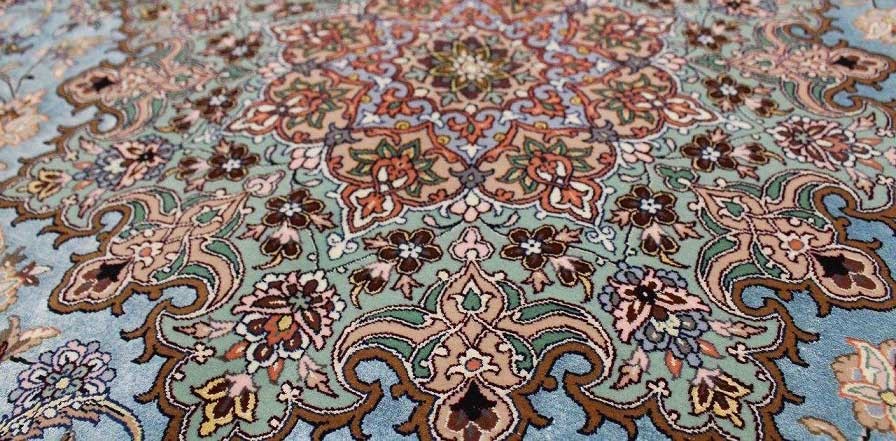
Tabriz Carpets
The city of Tabriz is located in Azarbaijan province, north-west of Iran. This old town has survived multiple destruction caused by numerous earthquakes and foreign invasions such as the Mongols, Tamerlane, Ottomans and Russian occupations. People of Tabriz speak Azeri which is one of the main Turkish dialects.
Tabriz has been a large and worldwide famous carpet making center in Iran and in the world. It played a significant role in development the rich traditions of the decorative and applied arts. Today, carpet industry of Tabriz is extensive and the quality varies from excellent handicrafts to simple and cheap market qualities. Tabriz has one of the most diverse displays of designs from medallion, Herati/Mahi, to figural, pictorial, and even 3D shaped rugs.
Isfahan Carpets
The city of Isfahan is located in central Iran at the foothills of the Zagros mountains. This city enjoys a rich history in carpet production and fine art. Isfahan was chosen as the capital city of Iran during the reign of the Safavid king Shah Abbas I and the city reached its pinnacle under his rule due to a renaissance of art throughout Persia. Throughout centuries, many cultures have settled in Isfahan, and to this day the cosmopolitan city is awash with intricate artwork, outstanding mosques, old bridges, palaces and world famous architecture. Aside from architecture, Isfahan is well known for its fine carpets, textiles, handicrafts, metal-workings, as well as traditional food and sweets.
IRAN ART EXHIBITION: Knotted on either silk or cotton foundations, with soft smooth wool and a very tightly woven pile, Isfahan rugs are of an excellent quality. The Isfahan rugs have been among the best and the most valuable carpets in the world. The most popular design is a central medallion surrounded by vines or flowers which are usually red, blue or indigo on an ivory background. Other popular design elements and motifs include vase, garden and tree of life designs, Shah Abbasi motifs, and pictorial pieces.
Iran Carpet Museum
The Iranian Carpet Museum is one of the best and most well-known museums in Tehran, in an area of 3400 square meters. In this museum, you can see all kinds of carpets, from hand-woven carpets to various types of kilims.
Carpet museum of Iran is one of the best places where history and art can be seen together in one place. 135 Iranian carpet masterpieces from different periods (15th century up to the contemporary time) are kept in this museum -Handwoven pieces from different cities and tribes of Iran such as Kashan, Isfahan, Tabriz, Kerman, Kurdistan and Khorasan.

